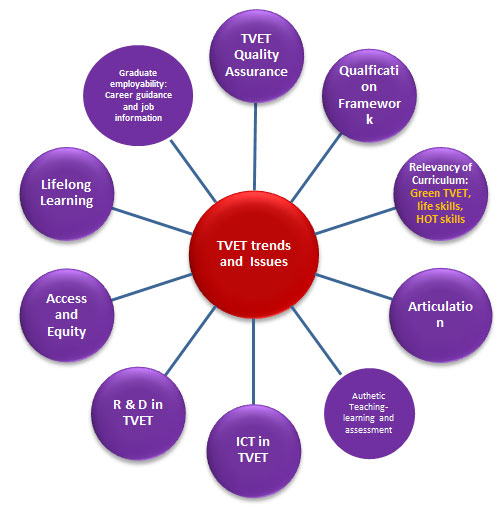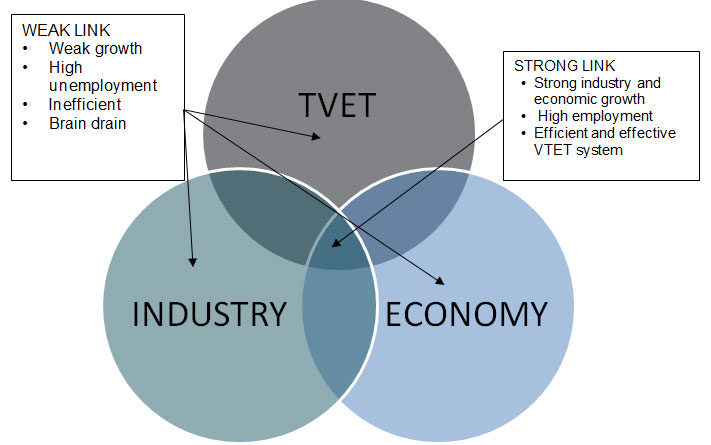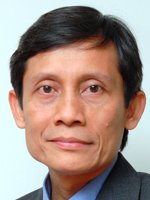Abstract
In anticipation of the ASEAN Integration, especially regarding the ASEAN Economic Community (AEC) 2015 it is clear that many aspects have to be considered and integrated in technical and vocational education and training (TVET). Four major thrusts under AEC include a single market and production base, a highly competitive economic region, a region of equitable economic development, and a region fully integrated into the global economy (ASEAN Secretariat 2010). These thrusts encourage country members to collaborate in several areas. The areas that link closely to TVET, among others, are human resources development and capacity building, recognition of professional qualifications, and the integration of industries across the region to promote regional sourcing. SEAMEO VOCTECH as a regional centre for TVET in Southeast Asia plays an active role in addressing the three mentioned areas. This paper will highlight the centre’s roles and initiatives relevant to AEC 2015, especially in the areas of capability building programmes for TVET instructors and administrators, its engagement with partners in the mutual recognition arrangements, and initiative in arriving at TVET quality standards. This paper also shares TVET trends, issues and challenges based on the Training and Research Needs Analysis survey completed in 2013. These trends and issues help shape the centre’s programmes and services, especially in addressing the initiatives in response to the ASEAN Economic Community.
1 Background
There are a few ASEAN initiatives that support regional integration. These initiatives support the three main pillars featuring socio, cultural, and economic integration. In line with the ASEAN Vision of 2020, the ASEAN Leaders decided to transform ASEAN into a stable, prosperous, and highly competitive region with equitable economic development, and reduced poverty and socio-economic disparities. In 2003, ASEAN Leaders declared that the ASEAN Economic Community (AEC) is to be the goal of regional economic integration. The establishment of the ASEAN Economic Community will incur transforming ASEAN into a region with free movement of goods, services, investment, skilled labour, and a freer flow of capital (ASEAN Secretariat 2010).
The AEC is to establish ASEAN as a single market and production-based, making ASEAN more dynamic and competitive with new mechanisms and measures to strengthen the implementation of its existing economic initiatives; accelerating regional integration in the priority sectors; facilitating movement of business personnel, skilled labour and talents; and strengthening the institutional mechanisms of ASEAN (ASEAN Secretariat 2010).
In facilitating the free flow of services by 2015, ASEAN is also working towards recognition of professional qualifications with a view to facilitating labour movement within the regions. One of the initiatives is facilitating harmonization and standardization.
In summary, there are Initiatives for ASEAN Integration (IAI) that relate to TVET. These include: (a) human resources development and capacity building (b) recognition of professional qualifications, and (c) integrating industries across the region to promote regional sourcing. This paper will elaborate SEAMEO VOCTECH’s relevant initiatives and other efforts made by other organisations or institutions that may help facilitate the above cooperation.
2 SEAMEO VOCTECH’s initiatives in response to human resources development and recognition of professional qualifications
Every member of ASEAN regards human resources as its highest priority. As a regional centre SEAMEO VOCTECH, has been and will continue to offer capability building programmes to improve the quality of human resources by providing training for TVET instructors and administrators. The areas of training for in-service teachers and other education personnel will be linked to addressing the issues and challenges and be relevant to the current TVET trends and issues identified by the centre.
The centre identified the 10 most salient trends and issues related to TVET considered to be input for providing relevant services to the member countries. These trends and issues were identified, based on the Needs Analysis Survey conducted from December 2012 to February 2013. The survey was sent to 104 experts, policymakers, and SEAMEO VOCTECH Governing Board members. Among those surveys, 24 were completed and returned to the centre. The findings then to be discussed and shared in the 24th SEAMEO VOCTECH’s Governing Board Meeting in Ha Long City, Vietnam. The final list of the trends and issues are (1) TVET quality assurance, (2) qualification framework, (3) relevancy of curriculum to incorporate green technology, employability skills including entrepreneurship and high order thinking skills, (4)articulation, (5) authentic teaching-learning and assessment, (6) ICT in TVET, (7) research and development, (8) access and equity, (9) lifelong learning, and (10) graduate employability (SEAMEO VOCTECH 2013) (see Figure 1). The details can be seen in the following pages.
The centre will continue to address the above trends and issues by offering relevant training programmes, continue conducting research studies to assist in the improvement of TVET in the member countries, and publish relevant reports and guidelines that can be used as references. For the training programmes, emphases have been placed on teachers and administrators and “soft” competencies, such as curriculum development, educational management, ICT, teaching and assessment, and research methodologies and project evaluation. In addressing the issue of lacking technical and vocational skills, the centre has begun initiating teaching technical skills training of TVET teachers in collaboration with partners.
In collaboration with its partners, the centre will facilitate dialogues among various stakeholders both with the individual country members or regionally. Of the many themes to be addressed high on the list will be the mutual recognition arrangements, TVET quality standards, mutual recognition arrangement (MRA), and competency standards development.
3 Identified trends and issues of TVET in Southeast Asia
The TVET trends and issues identified from the Training and Research Needs Analysis 2013 is illustrated in Figure 1.
Figure 1: TVET trends and issues in Southeast Asia
3.1 TVET Quality Assurance Framework
In preparation for AEC 2015, particularly on the growing mobility of students and workers, the SEAMEO member countries have been venturing into improving the connectivity of their TVET systems to support regional economic integration via cross-border investment and the mobility of skilled labour. Currently, these processes have striven towards mechanisms for improving cross-national connectivity, particularly regarding occupational standards and qualifications. The development of Regional TVET quality assurance and qualification frameworks serves to build connectivity among the various education and training modalities across the region.
One of the organisations spearheading the regional quality assurance framework is the East Asian Summit (EAS). The purposes of this proposed TVET QAF are to (1) enable countries to promote and monitor the improvement of their quality assurance systems; (2) facilitate cooperation and mutual understanding between member countries; and (3) support other initiatives within and across the region that enhance connectivity, integration, education and labour mobility, e.g. the ASEAN Regional Qualifications Framework. This is a coherent package capable of guiding the design and implementation of measures to strengthen quality assurance at the national level as well as providing a basis for alignment between national TVET quality assurance strategies (ASEAN 2012).
SEAMEO VOCTECH has been active in participating the meetings and workshops to finalise the draft of the plan. The response from most SEAMEO member countries has been very positive. Considering this framework is only for guidelines, each country may use it as a reference for adopting it.
3.2 National and regional qualification frameworks
National qualification frameworks are to be used as a means for promoting the development, implementing and facilitating of a transparent mechanism used in the assessment, certification, and recognition of skills. Regardless of the different levels of NQF, whether comprehensive or partial, most countries in the region, such as Malaysia, the Philippines, Indonesia, Singapore, Thailand, and Cambodia have formulated their NQFs. Three countries in SEA: Malaysia, Indonesia, and the Philippines have comprehensive NQFs that recognize any learning, regardless of the site (i.e. where the learning takes place), the form of provision (formal, informal, and non-formal), and the types of pedagogy and curriculum used. Other countries have “partial” NQFs whereby not all education and training qualifications are included in the framework. Some place emphasis on higher education while others emphasize TVET to a greater extent.
There have been several attempts by various organisations to develop an ASEAN Regional Qualification Framework in Southeast Asia. Many feel that an RQF will provide a reference point and translation grid for all qualifications throughout Southeast Asia and that it will benefit employers, education providers and job seekers to recognize qualifications issued within the region. Others feel that the RQF will only function if all member countries recognize its benefits and support its initiation and implementation whole-heartedly. Based on the current status, the development of a comprehensive ASEAN RQF still has a long way to go. To move forward, there is a need to identify major obstacles including reaching a mutual understanding between the “sending” and the “receiving” countries and identifying key players for the taskforce. It requires strong and long-lasting commitment by the participating countries and entails strong collaborations within and across ministries, and other stakeholders in the participating countries. Nevertheless, there have been significant steps towards an ASEAN RQF that will facilitate student and labour mobility in the region.
3.3 Relevancy of TVET curriculum
This is a prevalent and an on-going issue facing TVET institutions. Some issues of curriculum relevancy include the integration of high-order thinking skills, integration of employability skills, the inclusion of entrepreneurship education, and the adoption of green technology.
Articulations
To create effective and efficient TVET systems, articulation among educational institution must be established. Articulations can be done horizontally and/or vertically. Horizontal articulation is done at the same level of education by recognizing or matriculating credits of courses from one school to the other, e.g. matriculating courses from secondary TVET institutions to secondary academic schools or vice versa, from postsecondary TVET institutions to postsecondary academic institutions or vice versa.
Vertical articulation is carried out between lower level TVET institutions to a higher level. This type of articulation is taking place in several countries in the region. To encourage students to enrol in TVET and avoid the repetition of courses, the approved courses and credits from the lower level of education can be transferred to the next education level according to matriculation mechanisms.
3.4 Teaching-learning and assessment
Teaching-learning and assessment are the core of TVET activities to be revisited and continuously improved. Authentic teaching-learning and assessment have been gaining popularity as this approach is believed to be relevant for TVET context. The term “authentic” implies that the teaching-learning and assessment should be as similar to the real working environment as possible i.e. real problems, practical solutions, real approaches of solving the problems, multi (holistic) ways of assessing students.
3.5 ICT in education
The trend regarding Information and Communication Technology will still be relevant for the next five years. As yet ICT has not been fully integrated into TVET. Much effort must be invested to continuously enhance ICT integration in education. The digital divide persists not only between countries but as a domestic problem also. Following the UNESCO framework of ICT integration whereby ICT integration is grouped into 4 stages: emerging, applying, infusing, and transforming; many countries in the region are still only at the emerging and applying stages.
3.6 Research and Development
For the member countries of SEAMEO and the region to continuously innovate and develop, it is imperative that research and development activities are enhanced. Research activities should be proliferated particularly via networking and partnerships. More importantly, a platform should be constructed from which research findings can be shared through seminars, conferences, and publications, and most importantly via an online research database.
3.7 Access and Equality
To meet UNESCO’s millennium development goals, particularly regarding the Education for All agenda, all countries in the region are continuing to provide wider access to quality TVET. This access to TVET should be open to those who need it, regardless of their background. Through the use of ICT, TVET can be more accessible to many.
3.8 Life-long learning
Education, including TVET, should offer more flexibility to students and provide a strong foundation life-long learning. Likewise, there should be a mechanism to recognise prior learning regardless of whether the learning was acquired from a formal, non-formal or informal setting. The easy access to information through various media and the possibilities of carrying out jobs through various ways and means presents an open opportunity to individuals to learn continuously throughout their lives regardless of age.
3.9 Graduate employability
The issue of graduate employment is still prevalent in most of the countries in the region. This may be caused by mismatched qualifications, the lacking employability of the graduates, and/ or lacking of job openings or information. There is a need to provide and improve career guidance for the students and trainees at an early stage and incorporate the necessary competencies for enhancing graduate employability in the teaching-learning processes. To address the unemployment issue, it is also vital the graduates have access to job information. This job information may cover the job openings at the local, national, or even at the regional/international level.
4 The way forward
Human resource development is the most crucial development agenda in every country, yet many countries still lack proper planning. One focus HRD planning is TVET, especially for the preparation of technicians and skilled employees. It is difficult to create a perfect balance between the supply and demand of a labour market that is to support the national economy. Most of the time, country planning is not in line with the society interest for the type and level of education and training. Some countries possess abundant low level skills workers but have an extreme lack in terms of a high level workforce; while others may have the opposite problem. A study has shown that the closer the proportion between the demand and supply of the labour force the better the country’s economic development, see Figure 2.
Figure 2: The links between vocational TVET, industry (employment) and economy (adapted and modified from Ezzine 2012)
Three types of education and training occur in all countries, formal, informal and non-formal. In most cases, the link between these three types of education and training is not clear as there is no real system for recognizing prior learning. In TVET, in-formal and non-formal learning is still barely recognized which places the individual at an extreme disadvantage. It is important to encourage lifelong learning by establishing training and testing centres that can provide avenues for every individual to upgrade their competencies and obtain certification regardless of where and how the skills were acquired. There is a need for articulation across various education and training levels and recognition of the certification for employment, and many countries in the region are still very lacking in meeting the requirements for this.
To be able to recognize candidate’s qualification, it is important to have clear competencies spelt out in the certification/credentials. These distinct competencies must also be accompanied by strong quality assurance, so that whatever listed competencies may be the certificate is an accurate reflection of the holder’s capabilities.
This should be followed by installing a framework that can be used as a reference for any qualifications – commonly termed a qualification framework. Many countries in the region have a national qualification framework, but not many have successfully implemented it. This is due to lack of recognition by employers or even the Ministry of Labour. Some NQFs are still fragmented reflecting only a part of the education and training level (e.g. excluding higher education) or type (excluding non-formal and in-formal education. The comprehensiveness of the qualification framework is needed to increase the usefulness of the framework which simultaneously benefits the candidates.
In anticipation of AEC, recognition of qualification across national border is needed. This should be facilitated by a regional framework or at least an agreed mutual recognition among the countries. Mutual recognitions in some professions have been implemented but remain limited to certain areas (surveying and mapping, construction, hospitality and tourism) and certain countries. It is still a long way from constructing a firm regional qualification framework or more comprehensive mutual recognition of professional qualifications which could very likely hinder or prolong the preparedness for implementing AEC by 2015.
The discrepancies of educational and training systems among ASEAN member countries may also form obstacles to the progress in establishing cross-national recognition of professional qualifications. Willingness and commitment among member countries, is ultimately necessary particularly at the implementing agency level.
There are plenty of initiatives under the auspices of the AEC, but no clear mechanism to monitor their implementation. A taskforce is needed to implement each of the agreed initiatives; without it all of it will remain only as plans.
References
ASEAN Secretariat (2010). ASEAN Economic Community Blueprint. ASEAN Jakarta. Online: http://aseansec.org/21083.pdf (retrieved 10.10.2013).
Ezzine, M. (2012). Promoting TVET as key tool for skills development and youth employability in the Arab region. A paper presented at TVET Expert Meeting in Oman.
SEAMEO VOCTECH (2013). Fifth Five-Year Development Plan. SEAMEO VOCTECH: Brunei Darussalam.
Citation
Paryono (2013). Anticipating ASEAN Economic Community 2015: Regional initiatives on human resources development and recognition of professional qualifications. In: TVET@Asia, issue 2, 1-8. Online: https://www.tvet-online.asia/issue2/paryono_tvet2.pdf (retrieved 30.12.2013).




